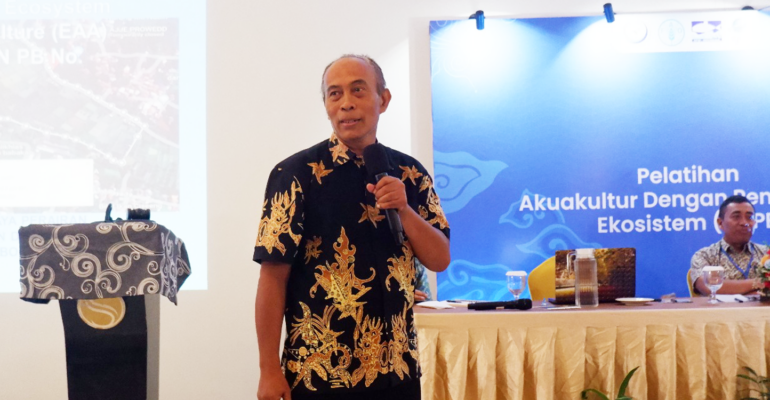IPB University Expert Presents Six Strategies for the Aquaculture Industry in the Face of Climate Change

Climate change, such as rising temperatures, changing rainfall patterns and extreme weather, will pose various threats to aquaculture. The effect is very large on water quality which will directly affect the health and productivity of the aquaculture system. This was revealed by Permanent Professor of Aquaculture Environmental Science at IPB University, Prof Eddy Soeparno.
“The solution to overcome this is to implement an effective management strategy. One approach is through a thorough understanding and monitoring of water quality parameters that greatly affect the survival of aquatic species and the success of the aquaculture industry,” explained Prof Eddy on Thursday, 22/2.
“These challenges can be overcome with various strategies, namely, first, identifying areas affected and not affected by climate change. Through this approach, the aquaculture industry can proactively respond to climate change and minimize the risk of impacts that can occur, “he said in the Pre Scientific Oration Press Conference for Professor of IPB University online.
He continued, the second strategy is area-based aquaculture management. “By combining the application of the Ecosystem Approach and Aquaculture (EAA) in the Aquaculture Management Area (AMA), the aquaculture industry can become more adaptive, efficient, and contribute positively to the overall ecosystem balance,” said this Lecturer of Aquaculture, Faculty of Fisheries and Marine Science (FPIK) IPB University.
Prof Eddy explained the third strategy, namely monitoring and evaluation based on Early Warning System (EWS) with a combination of Smart Aquaculture System and Precision Aquaculture which can create a new paradigm in aquaculture management.
“This not only helps improve the resilience and sustainability of the industry, but also opens up potential for higher production efficiency, reduced environmental impact and improved product quality,” he said.
He revealed that the fourth strategy is to develop sustainable technology based on local resources. “The combination of technological innovations such as Recirculation Aquaculture System (RAS), aquaponics and biofloc based on local resources, aquaculture can become more adaptive to climate change, create a sustainable production system, and make a positive contribution to global food security.”
“The fifth strategy is the application of ecological aquaculture with the integration of container color engineering which proves that technological innovation and ecological approaches can work together to create a more adaptive and environmentally friendly aquaculture system,” he said.
The last strategy, he continued, is to develop a roadmap for aquaculture development using advanced monitoring technologies, such as artificial intelligence sensors and Geographic Information Systems (GIS), so as to improve the accuracy and responsiveness of this design map.
“It is hoped that the proposed strategy will be able to improve the current and future conditions of aquaculture activities with the challenges of climate change and can provide an increase in aquaculture production,” concluded Prof Eddy. (Lp) (IAAS/Ard)



